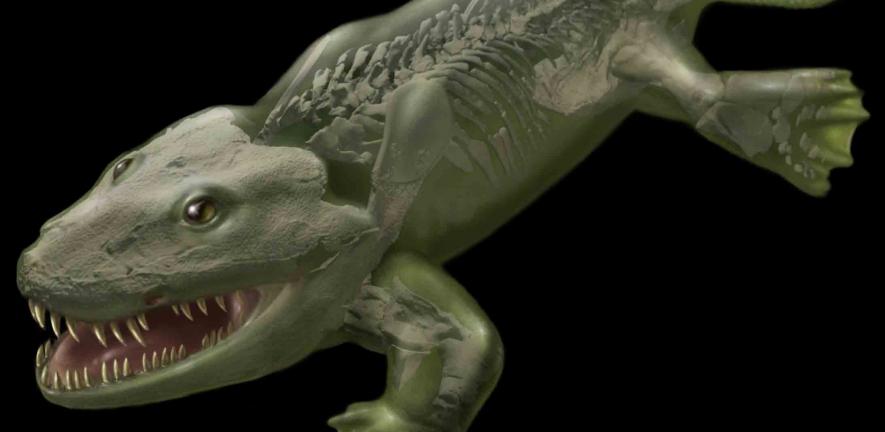
Early tetrapod primarily used front limbs to move and its back limbs for balance.
Early tetrapod primarily used front limbs to move and its back limbs for balance.
Our reconstruction demonstrates that the old idea, often seen in popular books and museum displays, of Ichthyostega looking and walking like a large salamander, with four sturdy legs, is incorrect.
Professor Jennifer Clack
An ancient four-limbed creature that’s thought to be the first ever to walk on land couldn’t actually walk at all, researchers have discovered.
Instead, they think the animal, which scientists call an early tetrapod, simply hauled itself out of the primordial ooze with its two front limbs, using its back limbs merely for balance.
"These early tetrapods probably moved in a similar way to living mudskipper fishes in which the front fins, or arms, are used like crutches to haul the body up and forward," explains Dr Stephanie Pierce from The Royal Veterinary College and University of Cambridge, lead author of the study, published in Nature today.
Pierce and co-authors, Professor Jennifer Clack from the University of Cambridge and Professor John Hutchinson form The Royal Veterinary College, made their discovery by creating the first ever 3D computer model of an early tetrapod’s skeleton. Their aim was to work out how its limbs might have moved.
They scanned dozens of fossil specimens of a tetrapod that lived around 360 million years ago called Ichthyostega. They digitally separated the bones from the rock surrounding the fossils. Then they put each bone back together into a whole skeleton, ‘ like a jigsaw puzzle,’ using animation software, before carefully manipulating the model to estimate each joint’s range of motion.
To make sure their computer model was reliable, they built similar models of seals, salamanders, platypuses, crocodiles and otters and used the model to test their joint movements. They found that the model predicted a reliable amount of mobility.
Their model also revealed that the creature wouldn’t have been able to move its hip and shoulder joints very much at all. Not just that, but its limbs couldn’t rotate along their long axis, a movement that’s essential for locomotion in today’s land animals. This means it probably couldn’t push its body off the ground and move each of its limbs in turn.
"All this points to the idea that limbs may have evolved before the ability to actually walk. It also shows that just because you have limbs, it doesn’t mean you can walk," says Pierce.
"Our reconstruction demonstrates that the old idea, often seen in popular books and museum displays, of Ichthyostega looking and walking like a large salamander, with four sturdy legs, is incorrect," says Clack.
"Remarkably, earlier fishes (called tetrapodomorphs) had the ability to rotate their fins, so it seems that just as vertebrates were experimenting with terrestrial movement, the limbs became confined to mainly back-and-forth and up-and-down motions. It wasn't until tetrapods became more competent on land that they recovered the ability to rotate their limbs around their long axis," says Hutchinson.
The findings suggest that some of the 400 million-year-old footprints discovered in Poland two years ago - thought to have been made by similar tetrapods - may have been made by altogether different four-legged animals.
The study was funded by the Natural Environment Research Council (NERC).
Article courtesy of NERC.
This work is licensed under a Creative Commons Licence. If you use this content on your site please link back to this page.

